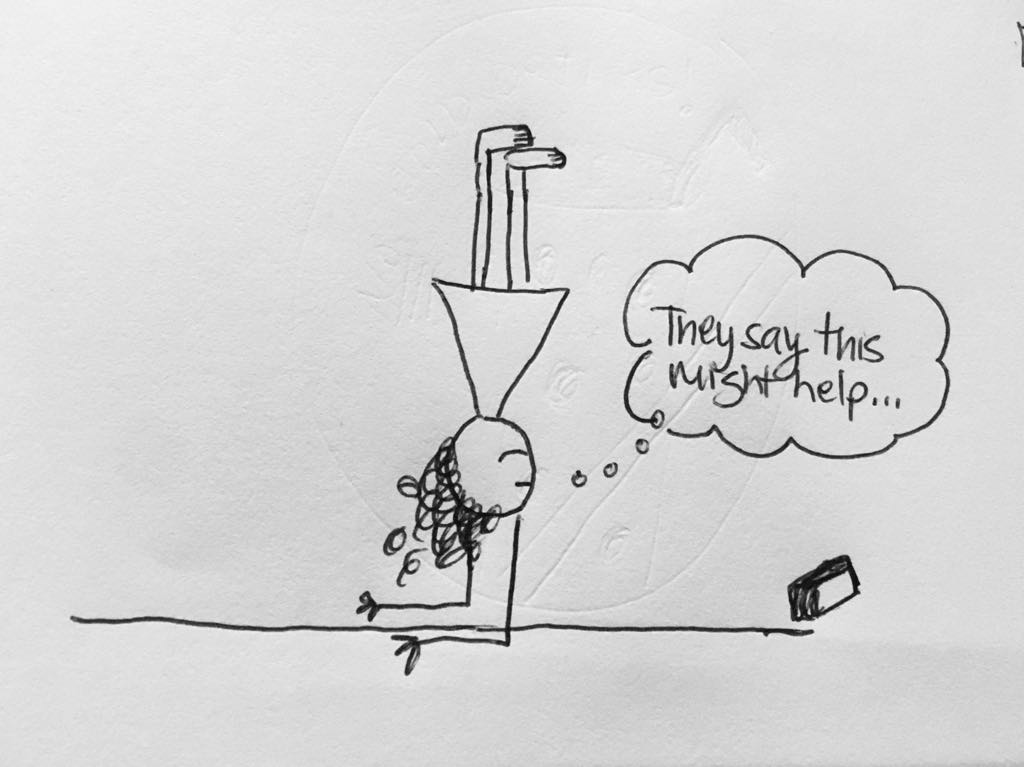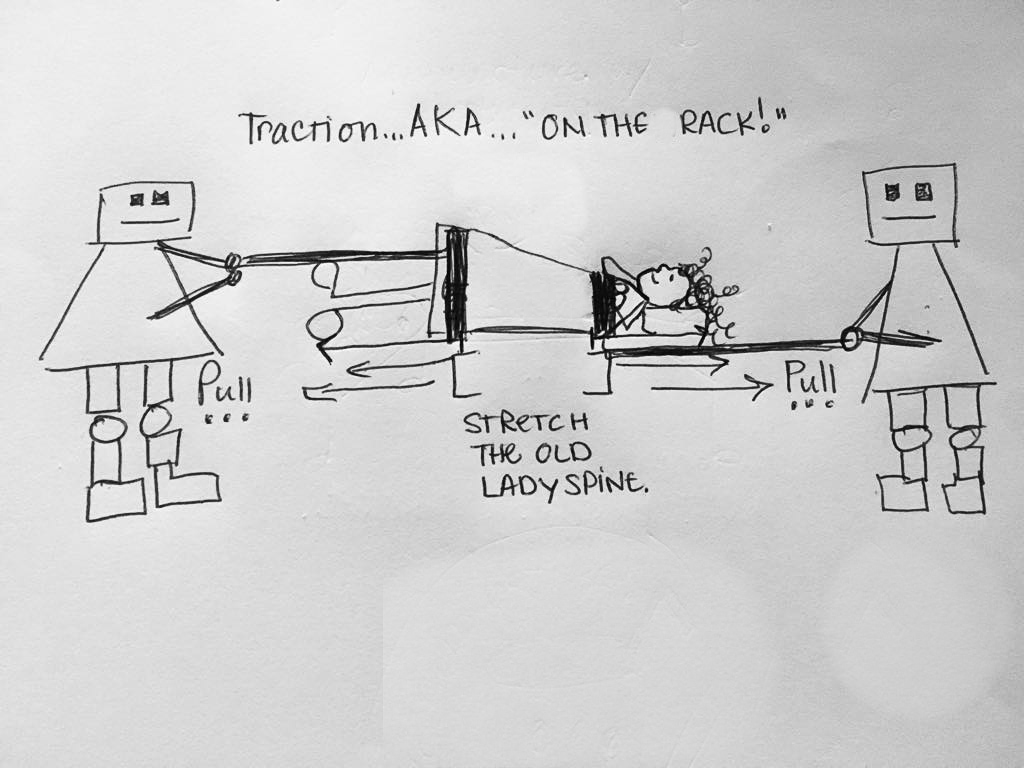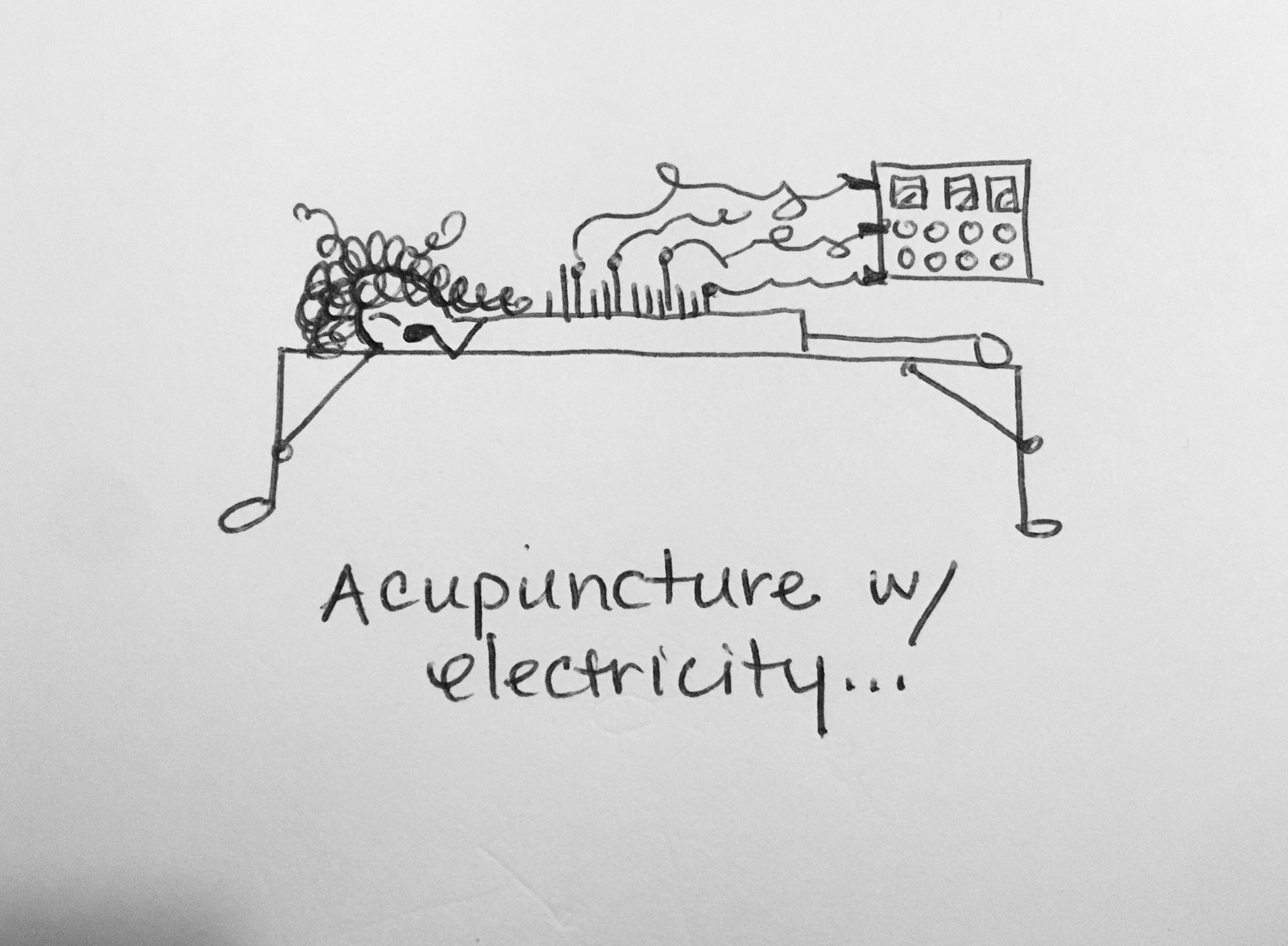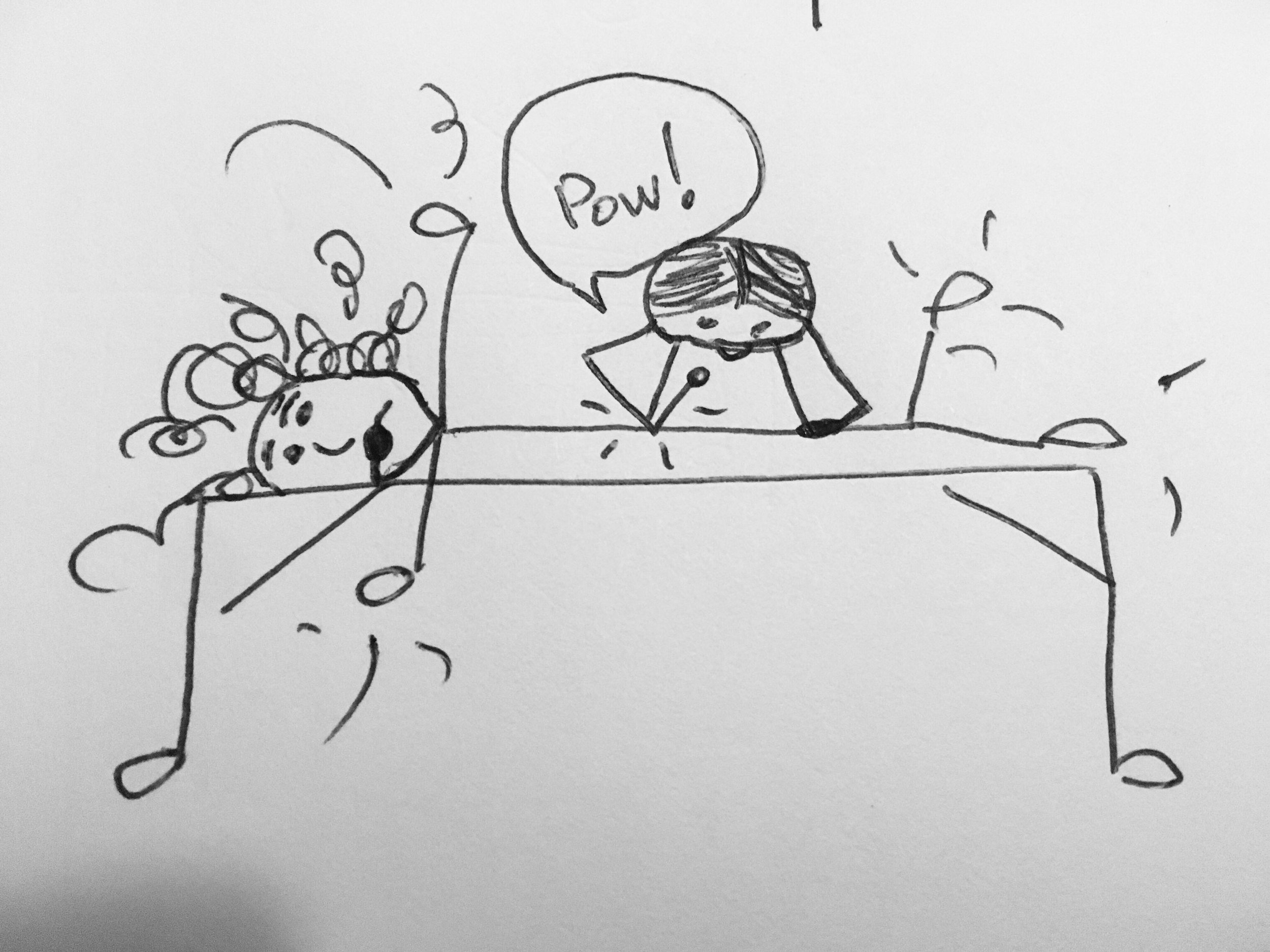“I’m not ready to submit to a surgery,” I tell Andrew. “My pain level isn’t bad enough, yet.”
“What are you talking about? You can’t stand up straight.”
“Yes I can.”
“No, you can’t. Even right now, you are hunched over with your butt sticking out.” He tells me. I do a self review and try to course correct, but nothing is moving like a normal skeleton should so I end up jutting out in elbows and corners that don’t make sense.
“There!” I say.
Andrew just scowls at me. “No.”
I haven’t written about this because let’s face it: it’s boring. But, I’ve spent the last couple months undertaking a number of repair efforts for my meat-suit – including Ice, Heat, Ibuprophin, tumeric, Yoga, traction, stretches, strength exercises, The Mackenzie Method physical therapy technique, Chinese herbs to cure the “cold wind in my belly,” several weeks’ treatment protocol with a particularly enthusiastic acupuncturist, and one voracious beating by this same Chinese man’s elbow.
I’ve run the gamut of every treatment protocol I can find either on the internet or in Langkawi. The only thing left at this point is another ghost removal, or as the orthopedic surgeon suggested: surgery.
But, if you are holding a hammer, everything tends to look like a nail. It is for this reason that I do not want to submit to a surgery until I know for sure that this surgeon isn’t just looking for his next nail to hit. Add to that, the fact that in my previous studies of back surgery (circa 2014), I recall reading that usually this type of surgery is successful and solves the problem once and for all. In some rare cases, though, it starts a waterfall effect in which a patient experiences the sequential weakening of all vertebrae above or below the disk subject to the original surgery. Sequential surgeries have lower and lower success rates until the patient ends up with a spinal fusion – which has a very low success rate, indeed. Given that this diagnosis is for the disc directly above the one I had problems with before, I am loathe to go down this route. I give my childhood doc a call back home, and he delivers several messages I don’t want to hear.
“What other choice do you have?” Andrew asks.
“I don’t know.” I say. “Maybe none! But, how intelligent is it to get sequential surgeries and then go out to sea where I am shaken like a paint can?”
“Is that the problem? Repetitive movements?”
“I don’t know, there are all sorts of potential causes listed and no one really knows for sure why this happens. Lifting heavy weight, poor posture, a weak core, genetics…”
“Well, you’ve tried everything except the surgery and the surgery worked last time. What are you going to do - nothing you love for the rest of your life? No sailing, no mountain biking? Nothing?” I hate it when he frames things like this. It’s the all or nothing false dichotomy. But, I see the fear in his eyes, and it probably matches my own. We both want to finish this sailing trip, we both love mountain biking.
“I don’t know, Andrew. What would you do?”
“Just get the surgery!” He says, as an engineer, a scientist, and a bright eyed optimist, he can’t see any reason I wouldn’t just get the surgery. Modern science is a miracle…
…sometimes. As a litigator, I’ve seen the other side. I’m intimately familiar with medical cases that go wrong for all number of reasons – everything ranging from a doctor reusing dirty equipment on patients to save a buck, doctors with good intentions who miss the mark, and also doctors who did everything right, but the patient’s body simply did not react well to the procedure. The practice of medicine is full of extraordinary complexities. Like always, Andrew sees opportunity, and I see risk. Though, I also accept there is risk in doing nothing, too.
“Don’t tell Sonrisa. I haven’t decided what I’m going to do, yet.” I text Andrew after he leaves to go to the yard. Sonrisa harbors a theory that I engage in these behaviors because I’m jealous of all the attention she is getting. I swear, I don’t!
Sonrisa’s latest beautification treatment at the Boat-Spa.
This conversation floats to the surface every few days like oil on water. And, it’s a terrible conversation to have while Andrew is hammering his way through Sonrisa’s keel bolt problem. He needs his mind right. He needs to feel like he can do anything he sets his mind to, and he needs the inspiration from our ‘inevitable next leg into the Indian Ocean’ to keep his momentum. The fact is, though, life does not go easy on you until you get all the things you want to get done, done. Bad luck, good luck, bad health, obstacles, and unexpected successes - all of these are in the flow with you at any given time regardless of what one chooses to do. We already know we have to eek out enjoyment and our Westward mileage while handling the unexpected things that come at us inside “the flow.” There isn’t another option.
“How long will a recovery take on a successful microdiscectomy?” Andrew asks.
“If it goes well, I’d probably be ready to cross oceans again in six months.” I tell him.
“Well, then, you have some time to decide. Let’s see how you feel mid-August. I just don’t understand what it is you think will change.”
But, I’ve been harboring a secret.
Just about one week before we flew to Penang, I had found a website called “Somatic Movement Center.” I click. “Discover the secret to living pain-free!” The opening byline says. I almost close it; how many “miracle cures” does the internet pedal? I’d rather have another fire healing. But, something about this website felt like a new protocol I hadn’t seen or tried before. Dveloped by a man named Thomas Hanna, it theorizes that musculoskeletal pain is caused by changes in our range of motion due to muscle memory. When we use the same postural/movement patterns, over and over again our brain tries to do us a favor. It memorizes those muscle movements and inserts them into our subconscious brain where we can automatically use those movements without thinking about it. Our muscles start taking the “easy way” and instead of using their full range of motion they move the shortest, quickest way to get our most repetitive jobs done. If you sit all the time, your muscles memorize the function required to sit most efficiently. If you are in waves, your muscles memorize the function required to keep you from toppling over most efficiently. They start to use that pattern over and over again because it’s familiar and easy – sometimes, even if you are not sitting. This is why people who look down at their cell phones a lot start to always have “forward head posture”
I am more than familiar with the process of gaining muscle memory from my years learning piano. Practice a mistake into your repertoire, and your brain will take that easy and familiar route over and over and over again. Hanna theorizes that the limited range of movement in our muscle memories is the “error” in our music and “over time, it causes damage to the structure of our bodies.” The limited range of motion causes the joints and frame work to move in a way it was not intended, and this wears ligaments, disks, joints, and causes us pain.
I’ve been worried because from the first day I visited my physical therapist here in Langkawi he told me: “sailing is always going to make it worse.”
“Why!? You’d think that sailing would strengthen your core and balancing muscles,” I plead.
“It does,” he agrees, “but it also requires you to tense and flex your muscles with every wave just to stay upright. You are tense, even in your sleep, your body is automatically tensing to resist movement in the waves.” I guess he knows. There are a line of sailors waiting at his door for all manner of hip, shoulder, back, knee and other problems.
Add to this, my previous decade spent hunched into a ball of indignation and fury while pleading my client’s case or typing a strongly worded email to set my opposing counsel’s head right. For a decade, I was hired to translate other people’s anger and frustration into their plea for justice as well as look out for risk that may create problems in the future. I’ll be the first to admit I’ve self-imposed the risk watchman role aboard Sonrisa. I don’t mind keeping these responsibilities, but I suspect I have a few muscles may have learned to stay tight.
So, I spent $45.oo on the introductory course and gave it a try while Andrew is away at the yard. Even in just the first week, I stopped taking Ibuprophin just to exist comfortably. Sure, I hobbled in to see the orthopedic doctor, but the week before I couldn’t even hobble.
A few nights later Andrew asks, “Do you know what this expense is? $45.00 to Somatic Movement Center. Is that for your back?”
Caught red handed! ”Yeah.” I say.
That night, I’m laying on my yoga mat doing exercises that from all outward appearances seems like…nothing.
“What are you doing?” Andrew asks.
I sit up and explain myself.
“Humph,” Andrew says, “More hippie exercises.”
“Maybe, but my next move is another fire healing. Take your Hippie Cure of Choice.”










